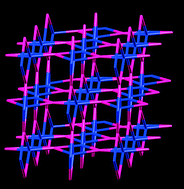Divergent 4,2′:6′,4′′- and 3,2′:6′,3′′-terpyridines as linkers in 2- and 3-dimensional architectures
Abstract
4,2′:6′,4′′-Terpyridine (4,2′:6′,4′′-tpy) and 3,2′:6′,3′′-terpyridine (3,2′:6′,3′′-tpy) typically coordinate through the outer pyridine rings, leaving the central ring non-coordinated. They therefore present divergent sets of N,N′-donor atoms and are ideal linkers for connecting metal nodes in coordination polymers and networks. This Highlight illustrates the strategies that are currently used to encourage the formation of 2- and 3-dimensional architectures as opposed to 1-dimensional chains. Functionalization in the tpy 4′-position with substituents such as pyridyl or carboxylate that can bind metal ions is one strategy. The second is to increase the coordination number of the metal centre. The third is to design ligands that contain multiple 4,2′:6′,4′′-tpy or 3,2′:6′,3′′-tpy domains.


 Please wait while we load your content...
Please wait while we load your content...